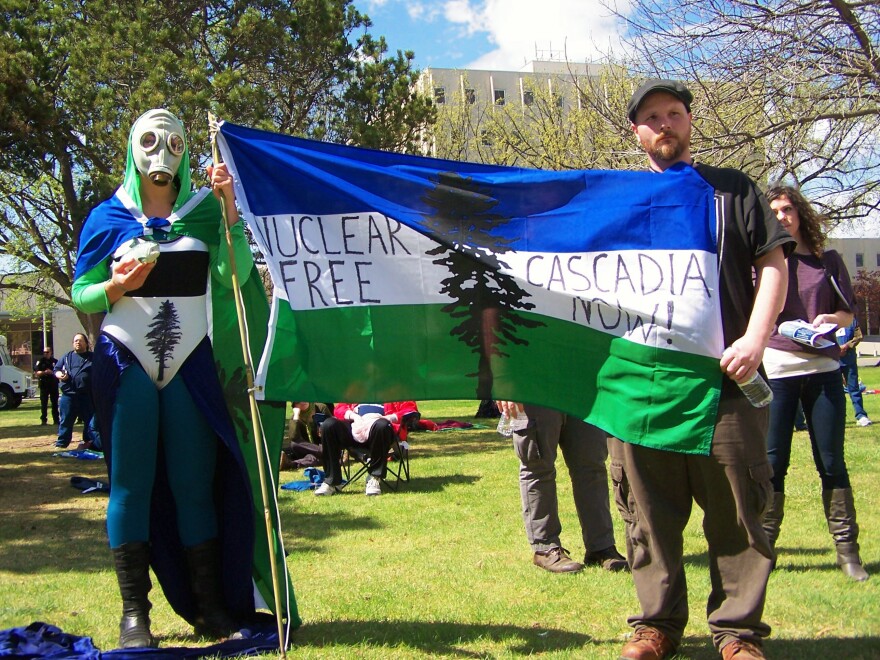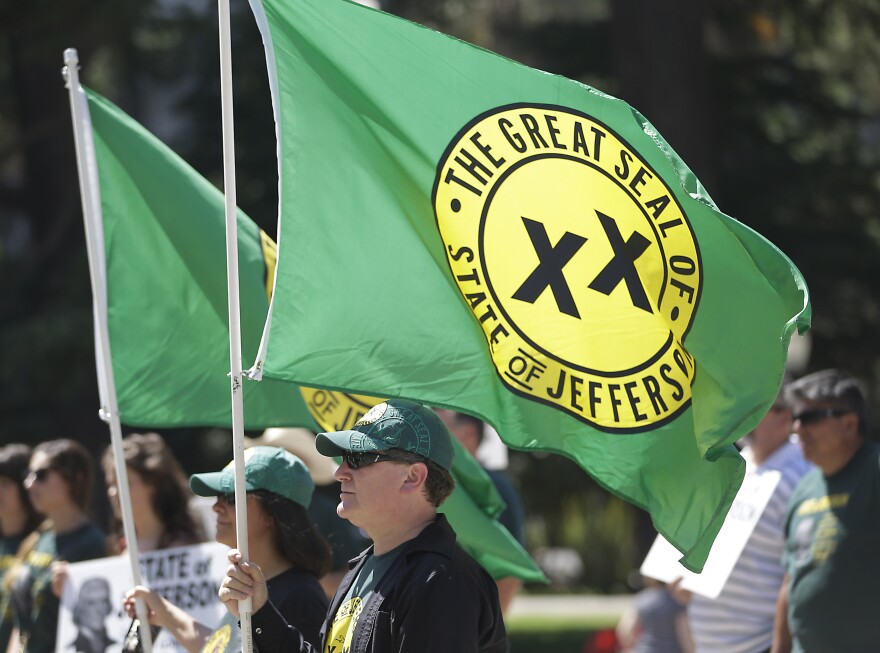On a recent, hot Saturday in Boise, about a dozen people came to Powderhaus Brewing Company to hear a pitch from a guy named Mike McCarter.
“Please adopt rural Oregon,” McCarter said on a stage with empty kegs stacked behind him.
And by adopting rural Oregon, he means he wants Idaho to absorb several conservative counties by extending the state’s border westward.
Despite being a lifelong Oregonian, he’s felt increasingly like an outsider in a state that’s become politically dominated by Democrats from the Portland metro area.
“In a way, some of the people look down on the rural people as farmers and ranchers and they work too hard and stuff like that,” McCarter said.
McCarter is president of Citizens for a Greater Idaho, a group hoping to create a conservative megastate in terms of landmass that he jokes would give the currently landlocked Idaho beachfront property.
About 800,000 people live in the 19 counties included in the Greater Idaho plan – less than the population of Multnomah County, which includes Portland.
As part of his pitch, slides from a projector flashed on a screen comparing the price of hunting licenses, tax rates and overall “freedom” between the two states.
“It’s a value movement of faith, family, freedom, independence, but it has a tendency to follow along political lines.”

But this isn’t the first time rural Oregon has tried to secede from the rest of the state.
“I’ve seen the banners still hanging out there,” McCarter said.
The banners he’s talking about are for the State of Jefferson – an idea that would’ve combined parts of southern Oregon and northern California.
The movement has roots dating back more than a century.
“I think a lot of people don’t realize that it was actually ongoing from the gold rush forward,” said Gail Jenner, a retired educator and author who writes about the State of Jefferson.
Gold miners, Jenner said, would tell officials they lived in one state or the other to avoid paying income taxes.
A few efforts to carve out the new state in the mid to late 1800s didn’t get much traction until the end of the Great Depression.
Jenner said the area was still exceptionally remote and locals dealing with the few, poorly maintained roads felt ignored by politicians in Sacramento and Salem.
“One of the statements that came out of the movement was, ‘Our roads aren’t passable. They’re not even jackassable,’” she said.
People in the region began organizing – some of it blown out of proportion or even staged by reporters and cameramen.
They designed a green flag with a gold pan in the center marked by two x’s to symbolize the feeling they were double-crossed by their respective states. They even named a state flower … in general terms.
“Anything but a pansy,” Jenner said.
All of it came to a head in 1941 when Judge John Childs from Crescent City, California became the first elected governor of the State of Jefferson.
“And then three days later, Pearl Harbor was bombed and so that whole movement sort of died to the war effort,” she said.
New attempts to revive the idea in the decades since didn’t pan out and Jefferson never fully recovered.
But separatist movements haven’t just been limited to conservatives in the northwest.
A group of environmentalists met in Olympia for the Cascadia Bioregional Conference in 1986 to plan a collective future for parts of British Columbia and Oregon and Washington west of the Cascade mountains.
The boundaries of the bioregion have increased since then, according to Brandon Letsinger, president of the Cascadia Bioregional Party, who lives in Seattle.
“It extends from Mount Saint Elias in the north in Alaska, all the way down to northern California and as far east as Yellowstone,” Letsinger said.
The idea behind a bioregion, he said, is to link together common communities by following the flows of a watershed instead of running a more centralized, governmental structure based on arbitrary lines.
“The people living here will always be the best able to represent their own interests and needs and starting with those communities, starting with the place that we live and building up will be much more effective than being a part of a country that’s just too big.”
The party fielded two candidates for the 2017 British Columbia parliamentary elections. They each got less than 1% of the vote.

Letsinger said he does feel a connection to the State of Jefferson movement, despite the significant political differences. People feel unheard and unrepresented.
“There is an overwhelming feeling that things are getting a lot worse in terms of climate, in terms of ecosystem, in terms of poverty and other issues,” especially after the last four years of the Trump presidency, he said.
That sense of alienation, Letsinger said, comes from not being able to affect broader change – whether it's dealing with water rights, immigration policy or environmental protections, regardless of which side you’re on.
It’s a similar feeling for Gail Jenner.
“Under all of it, there is a strong sense of being different and it still persists,” she said.
Jenner lives on a cattle ranch in Etna, California, the heart of the State of Jefferson. Her husband’s great, great, great grandfather founded Etna Brewing Company, which produces Double-Crossed IPA, the official beer of Jefferson.
Urbanites, or anyone who looks down on those living in rural areas, she said, have contributed to a significant cultural – and civil – divide in California, Oregon and the rest of the country.
“There are so many assumptions made and so there’s no communication and that really hurts everybody,” Jenner said.

The technical realities of moving state lines, and all of the costs that come with it, are vast.
Back at Powderhaus Brewing Company in Boise, one audience member asked leaders of the Greater Idaho movement who would pay for all of it.
The state would inherit from Oregon a vast system of rural roads, prisons, schools, among other considerations if the plan succeeds.
Organizers are currently trying to fundraise for an economic impact study to answer those questions.
Aside from convincing citizens from both states, Idaho and Oregon lawmakers would need to agree on the divorce terms and get approval from Congress.
So far, seven counties in Oregon have voted to study the issue and another rejected it.
Even if it all amounts to nothing, it seems like the spirit of the movement has no plans to move on any time soon.



